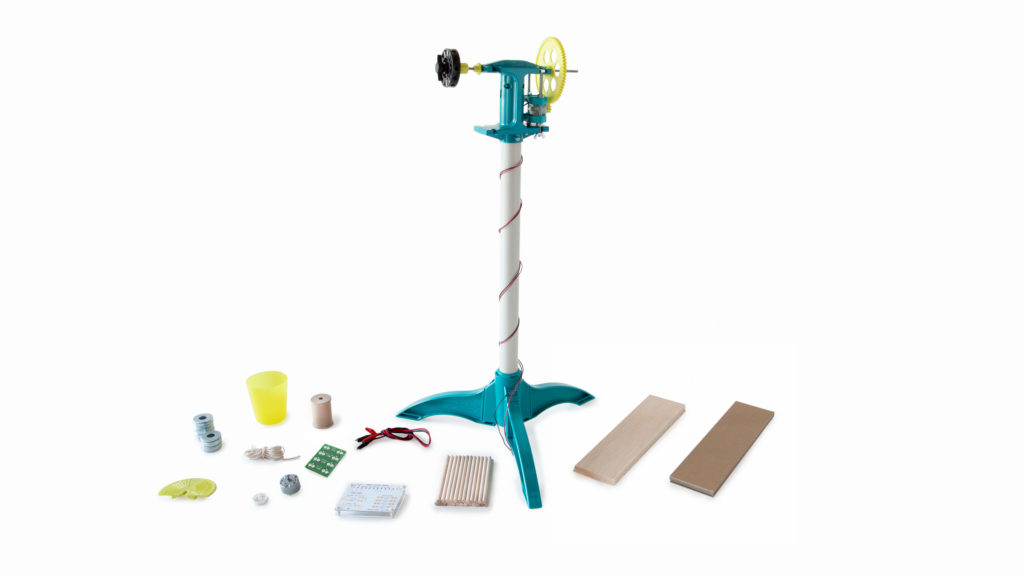KidWind Basic Wind Experiment Kit User Manual
Order Code: KW-BWX
The Basic Wind Experiment Kit is a great introduction to wind energy science and engineering concepts. This is a robust, experimentally rich turbine kit that is appropriate for middle and high school students.
Experimentally Rich
- Experiment with wind turbine blade design
- Measure electrical and mechanical power
- Test electricity production and weightlifting
Note: Vernier products are designed for educational use. Our products are not designed nor are they recommended for any industrial, medical, or commercial process such as life support, patient diagnosis, control of a manufacturing process, or industrial testing of any kind.
What's Included
- KidWind Power Output Board
Bag 1 (class pack contains 3)
|
Bag 2 (class pack contains 3)
Bag 3 (class pack only)
|
*This part is a consumable and is excluded from warranty.
Assembly Instructions
Assembling the Tower and Base
- Slide the legs into the tower hub until they click into place securely.
- Place the locking ring around one end of the tower and slide it into the tower hub.
- Make sure the tower is securely in place.
Assembling the Nacelle and Motor Mount
- Place the two nacelle halves together.
-
Using a Phillips-head screwdriver and the screws from the motor mount kit, secure the two nacelle halves together. Each side of the nacelle requires four screws to secure it together (see Figure 1).
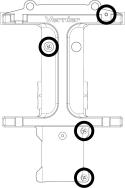
- Screw in a hex nut about two-thirds the way up a bolt.
- Slide the two motor mount sections, one at a time, up the bolt so that the two concave sections are facing each other.
- Screw another hex nut onto the bolt under the motor mounts to hold them in place (see Figure 2).

- Slide the bolt (with nuts and mount) into the cutout on the nacelle.
- Attach a wing nut onto the bottom of the bolt so that it is secured to the nacelle (see Figure 3).
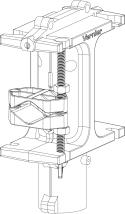
- Screw a hex nut onto a second bolt (about one-third of the way up).
- Slide that bolt into the top cutout and through the motor mounts.
- Screw a hex nut onto the bolt under the mounts.
- Move the hex nut up the bolt so that you can slide the bolt down all the way to the bottom cutout.
- Secure the second bolt with another wing nut, repeating what was done for the first bolt (see Figure 4).
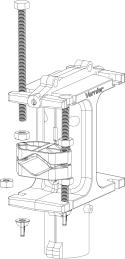
Attaching the Generator to the Nacelle
- Loosen the motor mounts on the nacelle until the generator can fit between them.
- Tighten the nuts up and down onto the motor mount to hold the generator securely in place.
Optional: If you are using a PVC tower, you can snake the wires from the motor through the slot in the nacelle behind the motor mount. Then the wires can go down through the PVC pipe. On a wood tower, the wires can go to the side of the nacelle. You can attach the wires to the wood tower with zip-ties or tape.
- Attach the smallest gear (pinion) to the driveshaft of the generator by pressing it on firmly with your fingers.
Attaching the Hex Driveshaft and Gear
- Slide a hex lock about two-thirds the way onto the driveshaft with the flange facing the nacelle.
- On the side opposite of the generator, slide the driveshaft, with the attached Hub Quick Connect, into the hole at the top of the nacelle.
- Slip a second hex lock onto the driveshaft with the flange facing the nacelle.
- Place the 16-, 32-, or 64-tooth gear onto the driveshaft and press it onto the hex lock.
- Move your generator up or down by adjusting the hex nuts so that the pinion gear meshes with the gear on the driveshaft (see Figure 5).
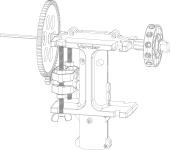
Mounting the Nacelle on the Tower
- Slide your nacelle onto the top of the tower. If your tower is PVC, you may pass the wires down the pipe. If your tower is wood, you can wrap the wires around the tower and attach them with zip ties or tape.
- If needed, use a set screw to lock the nacelle in place and prevent the nacelle from turning.
Generators
The Basic Wind Experiment Kit comes with one standard DC generator. This generator is the primary generator for wind turbine experiments because it runs smoothly and provides high power output at a relatively low RPM.
Two Do-It-Yourself generator options are available (purchased separately) to further investigate generator construction: KidWind simpleGEN (KW-SGEN) and GENPack (KW-GP). The simpleGen replaces the nacelle while the GENpack fits into the nacelle. For more information see www.vernier.com/til/13082
Power Output Pack
The KidWind Power Output Pack includes several load devices to test the power output of your wind turbine.
KidWind Power Output Board
The KidWind Power Output Board includes a visual voltmeter, resistors, a capacitor, and an AC-to-DC bridge rectifier. This device measures the power output of your small wind turbines or solar panels.
- The visual voltmeter gives a general indication of the potential difference produced by a power source. It does not give an exact voltage. If you need an exact measurement of the power source voltage, we recommend using a Vernier energy sensor (VES-BTA or GDX-NRG).
- The 1 W resistors (10 Ω, 30 Ω , 51 Ω, and 100 Ω) on the power output board can test how much load your turbine can handle.
- The capacitor can temporarily store electrical energy.
- The bridge rectifier can convert AC current produced by some sources, such as the simpleGEN, to a DC current.
Converting to the Weightlifting Turbine
You can convert your Basic Wind Experiment Kit to a weightlifting turbine. Lifting weights with the wind turbine is another great way to explore wind energy and provide students with a simple visual display of mechanical work. To convert the kit to a weightlifting turbine, watch the assembly video at https://www.youtube.com/watch?v=Sq_kK0U4vrY
- Remove the larger gear from the hex driveshaft, but leave hex lock on it. Note: You may wish to remove the generator, but it is not required.
- Push the wooden spool to lock into this hex lock, then insert the second hex lock behind the spool. The neck of the hex lock will fit inside the drilled hole of the spool.
- Attach one end of the string securely to the cup. This cup will hold your weights; a set of metal washers are provided for this purpose.
- Tie and tape the other end of the string onto the spool. The tape prevents the string from slipping.
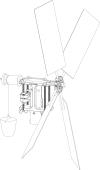
Troubleshooting
Information and troubleshooting tips can be found at www.vernier.com/til/3220
Accessories/Replacements Parts
| Accessory | Order Code |
|---|---|
|
GDX-NRG |
|
|
VES-RB |
|
|
KW-GEAR |
|
|
KW-DS |
|
|
VES-VL |
|
|
KW-GP |
|
|
VES-BTA |
|
| Replacement Part | Order Code |
|
KW-BDC |
|
|
KW-BPP |
|
|
KW-POP |
|
|
KW-MTRMNT |
|
|
KW-HIGEN3 |
|
|
KW-WTH10 |
|
|
KW-TH3 |
|
|
KW-GEN10 |
|
|
KW-GEN3 |
|
|
KW-CB50 |
|
|
KW-D25 |
|
|
KW-D100 |
|
|
KW-BBS10 |
|
|
KW-BB100 |
Warranty
Warranty information for this product can be found on the Support tab at www.vernier.com/kw-bwx/#support
General warranty information can be found at www.vernier.com/warranty
Contact Support
Fill out our online support form or call us toll-free at 1-888-837-6437.

